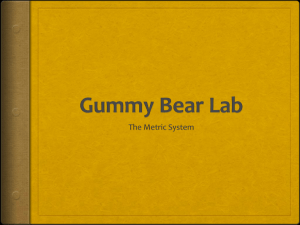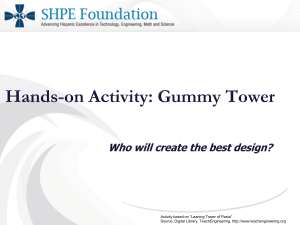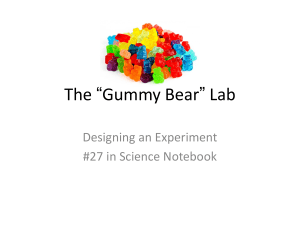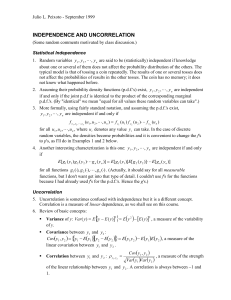The Differential Outcomes Effect (DOE
advertisement
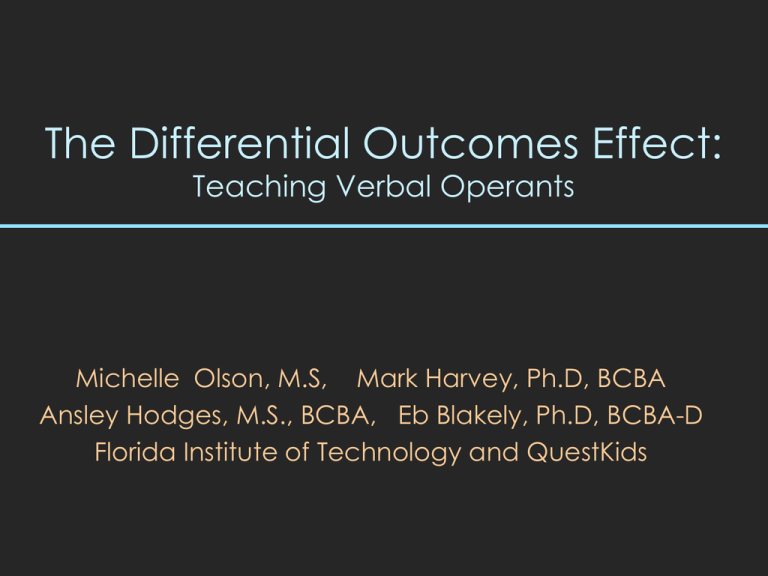
The Differential Outcomes Effect: Teaching Verbal Operants Michelle Olson, M.S, Mark Harvey, Ph.D, BCBA Ansley Hodges, M.S., BCBA, Eb Blakely, Ph.D, BCBA-D Florida Institute of Technology and QuestKids Typical Procedure “How old are you?” “How are you?” “8” “Fine” Preferred Item Preferred Item Differential Outcomes Procedure Different reinforcers in a discrimination task, correlated with each kind of response Differential Outcomes Effect Increase rate of acquisition and/or maintain higher steady state performance Lab Studies With Nonhumans: Variety of discrimination Paradigms Two Choice Discrimination Experiments Two-Choice Procedure: Correlated Outcomes Light Light LEFT Food RIGHT Water Two-Choice Control Procedure: Uncorrelated Outcomes Light Light LEFT RIGHT .5 Food .5 Water .5 Food .5 Water Two-Choice Control Procedure: Confound???? 1. Two reinforcers 2. Correlated outcomes Typical Food Food DOE Food Water Human Application: Correlated Outcomes “How old are you?” “8” Gummy “How are you?” “Fine” Music Human Application: Uncorrelated Outcomes “How old are you?” “How are you?” “8” “Fine” .5 Music .5 Gummy .5 Music .5 Gummy Experiment 1: Extension to Verbal Operants • Two boys with autism – 8 and 5 years old • QuestKids Academy – Experiment 1 Design • Alternating Treatments • Dependent Variable: – % correct of intraverbal responses • Independent Variable: – Correlated vs. Uncorrelated outcomes Baseline Procedure Response 4 Easy Tasks Target Question No Response 15 sec. ITI General Treatment Procedure Correct Answer 4 Easy Tasks Target question Wrong Answer / NR Correction Trial Outcome with (15 sec ITI) 15 sec ITI Intraverbal Tasks Correlated Task “What do you do with a watch?” “Tell time” Gummy “What do you watch?” “TV” Music Uncorrelated Task “How old are you?” “8” Gummy OR Music “How are you?” “Good” Gummy OR Music Video • Show video Clip Santi: Intraverbals Correlated Task “How old are you?” “8” Music “How are you?” “Good” Gummy Uncorrelated Task “What do you eat for breakfast?” “Toast, cereal” “When do you eat breakfast?” “Morning” Music OR Gummy Music OR Gummy Results Experiment 1: Santi BL Maint Tx 100 Correlated 90 80 70 60 50 40 30 20 Uncorrelated 10 0 1 2 3 4 5 6 7 8 9 10 11 12 13 14 15 16 17 18 19 20 21 22 23 24 25 26 27 28 29 30 31 32 33 34 35 36 Josh: Intraverbals Correlated Task “What’s your first name?” “Josh” Music “What’s your last name?” “Smith” Gummy Uncorrelated Task “What’s something you drink?” “Milk, juice” Music OR Gummy “What’s something you drink out of?” “Glass, cup” Music OR Gummy Results Experiment 1: Josh BL Maint Tx 100 Decreased # experimenters 90 80 Percent Correct 70 60 50 40 30 20 Uncorrelated 10 Correlated 0 1 3 5 7 9 11 13 15 17 19 21 23 25 27 29 31 33 35 37 39 41 43 45 47 49 51 53 55 Sessions Experiment 2: Extension to Intraverbals and Tacts • Two different boys with autism both 8 years old • QuestKids Academy – Experiment 2 • Design: – Alternating Treatments – Multiple baseline across verbal operants • Dependent Variable: – % correct responses – Note: 100% and 97%, IOA respectively • Independent Variable: – Correlated vs. Uncorrelated outcomes Caliel: Tacts Correlated Task D + “What letter?” “D” Gummy D + “What sound?” “duh” Music Uncorrelated Task B + “What letter?” “B” Gummy OR Music B + “What sound?” “buh” Gummy OR Music Caliel: Intraverbals Correlated Task “What do you do with a watch?” “Tell time” Gummy “What do you watch?” “TV” Music Uncorrelated Task “How old are you?” “8” Gummy OR Music “How are you?” “Fine, good” Gummy OR Music Results Experiment 2: Caliel 100 BL Intraverbals Tx Maint 90 Percent Correct 80 70 Uncorrelated Correlated 60 50 40 30 20 10 0 100 90 Percent Correct 80 0 1 2 3 4 5 6 7 8 9 10 11 12 13 14 15 16 17 18 19 20 21 22 23 24 25 26 27 28 29 30 31 32 33 34 35 36 37 38 39 40 41 42 43 44 Tacts 70 60 50 40 30 20 10 0 0 1 2 3 4 5 6 7 8 9 10 11 12 13 14 15 16 17 18 19 20 21 22 23 24 25 26 27 28 29 30 31 32 33 34 35 36 37 38 39 40 41 42 43 44 Sessions Austin: Tacts Correlated Task B + “What letter?” “B” Gummy B+ “What sound?” “buh” Music Uncorrelated Task D + “What letter?” “D” Gummy OR Music D + “What sound?” “duh” Gummy OR Music Austin: Intraverbals Correlated Task “What number do you call when there’s an emergency?” “911” Music “When do you call 911?” “When somebody’s really hurt” Chip Uncorrelated Task “What happens to ice when it’s heated?” “It melts / turns to water” Chip OR Music “What happens to water when you put it in the freezer?” “It freezes / turns to ice Chip OR Music Results Percent Correct Experiment 2: Austin Tx BL 100 90 80 70 60 50 40 30 20 10 0 Maint Tacts Uncorrelated Correlated 100 Intraverbals 90 Percent Correct 80 70 60 50 40 30 20 10 0 0 1 2 3 4 5 6 7 8 9 10 11 12 13 14 15 16 17 18 19 20 21 22 23 24 25 26 27 28 29 30 31 32 33 34 35 36 Sessions Discussion of Austin Why was uncorrelated more effective? Correlated Task “What number do you call when there’s an emergency?” “911 when somebody’s really hurt” Music “When do you call 911?” “911 when somebody’s really hurt” Chip Summary of Results Participant Intraverbal (DOE) Tact (DOE) Santi Josh x Caliel Austin x x Discussion • DOE procedure has promise in teaching verbal operants, especially intraverbals • Task difficulty critical element • Use when traditional procedures don’t work Discussion – Future Directions • Intraverbals replications • Recall / Comprehension (DTMS) • Different ages / abilities End For this PowerPoint and references Website: www.fitaba.com Email: eblakely@questinc.org Differential Outcomes Effect Match-to-Sample Traditional Discrimination Training Assay: Match-to-sample Food Choice stimuli Sample stimulus Food DOE Procedure Food Drink Sample stimulus DOE Procedure Food Drink Sample stimulus DOE Control Procedures Uncorrelated .5 Food/.5 Drink Sample stimulus .5 Food/.5 Drink Correlated Food Drink Sample stimulus DOE Procedure: Application Academic Tasks Candy Soda A B SD: “Point to A” SD: “Point to B” DOE Procedure: Application Recall Tasks Candy “Sandwich” Soda “My friend Will” SD: “What did you just eat?” SD: “Who did you just talk to?” Exercises The DOE is an effect in which different _________ are used for different ________ in a discrimination task. What is the proper control procedure in a DOE study? Pick a task that you are teaching, and design a DOE procedure for it.
